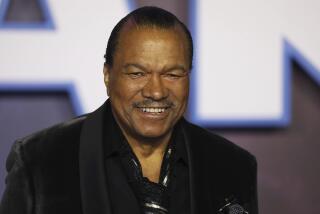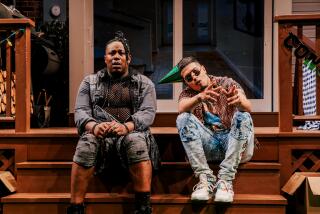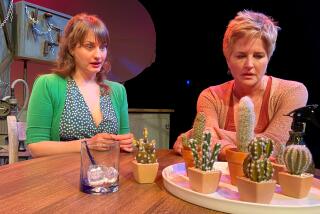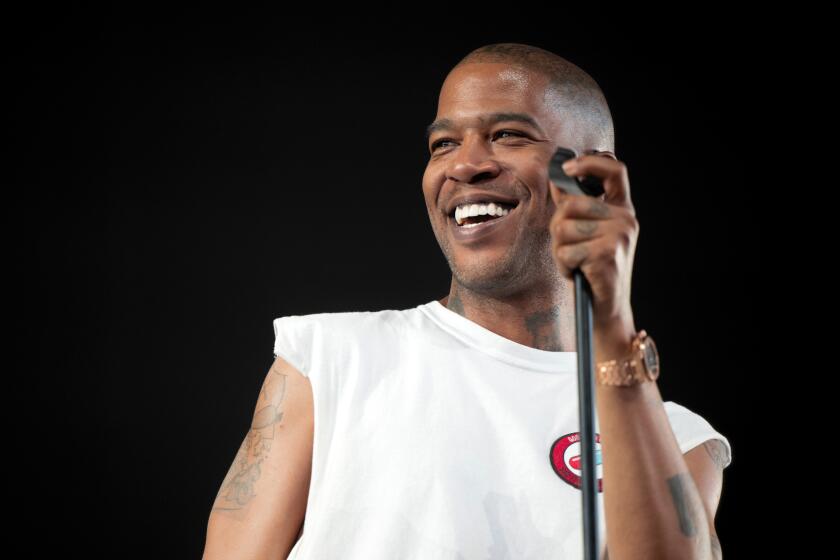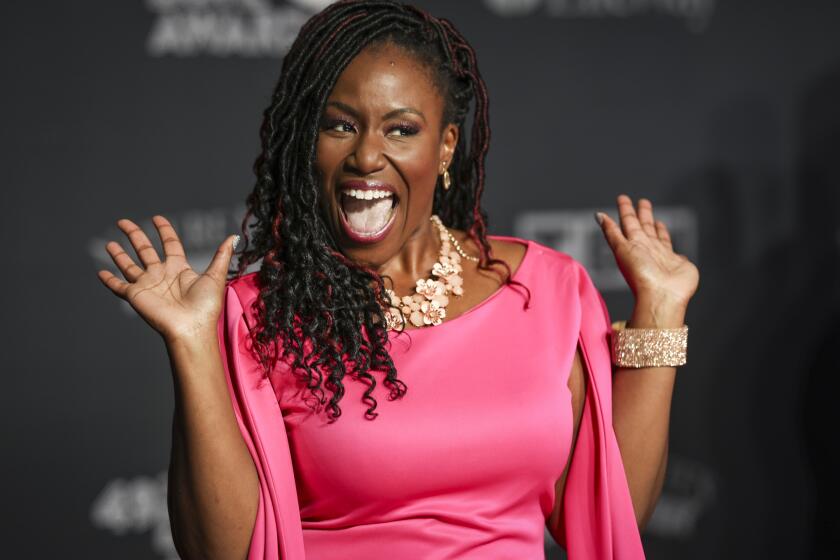Baddie role in ‘Peter and the Starcatcher’ hooked John Sanders
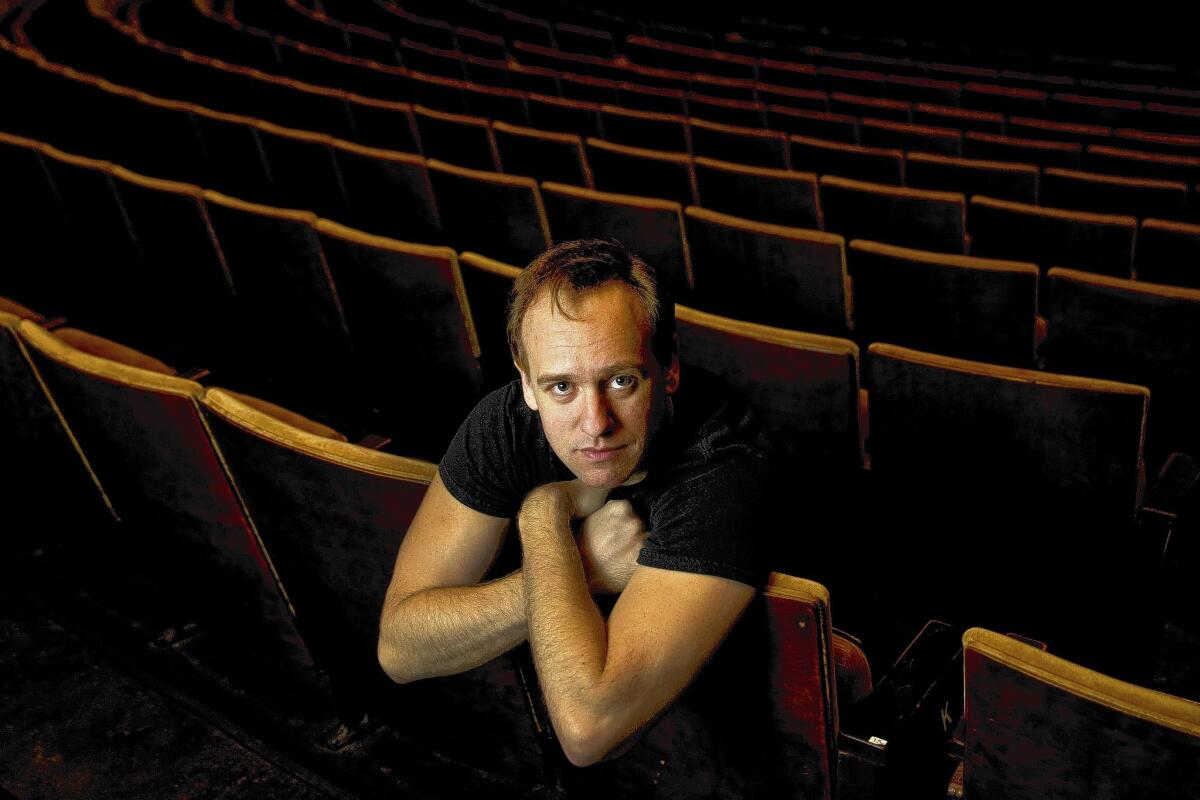
During his working hours, John Sanders sports a Groucho Marx mustache that looks like it has been applied with an extra wide black marker. The actor portrays the dashing, malaprop-dropping, always-hopping villain Black Stache in “Peter and the Starcatcher,” now on national tour at the Ahmanson Theatre through Jan. 12.
The Tony Award-winning play presents the back story to the Peter Pan tale, but it also imagines how a foppishly dressed pirate came to trade in his name and his notable facial feature for a hook. And even though it is not Black Stache’s story, which makes clear he is inept at plundering, the character nevertheless steals the show. (The play, based on a novel by Dave Barry and Ridley Pearson, was written by Rick Elice and is co-directed by Roger Rees and Alex Timbers.)
Below is an edited transcript of a conversation with Sanders, who understudied the role on Broadway.
PHOTOS: Arts and culture in pictures by The Times
What attracted you to the material? How did you come to get this part?
I was sent the script and .... well, I ran a new play development program in Chicago for five years and I’ve read a lot of new scripts and there have only been two scripts that I had just as good a time reading as I did experiencing it. One was Conor McPherson’s “Shining City” and the other one was this one. I fell in love with it.
How do you describe your character to someone who hasn’t seen the play?
Oh, man, he’s such a bundle of contradictions and weirdness. His humor is so arcane and a little elusive. Because he’s alone, and he’s surrounded by idiots. He’s trying to make the best of it. I guess I usually say he’s the villain of the piece and that villains are always a ball of fun, especially in a comedic fantasy like this one.
Your character eventually becomes Captain Hook, and we’ve seen that character quite a bit. Did that change the way you approached the role?
We’re all familiar with the Peter Pan story, and the characters are in our DNA. I’ve seen “Hook” and a lot of the other Peter Pan iterations over the years — it’s really just in me. But I didn’t go back and study for this character. It’s important to me that, even though it’s such a showy, fun time in the play, to present something that has some psychological plausibility.
CRITICS’ PICKS: What to watch, where to go, what to eat
Peter Pan gives Hook a goal, but this is before that, of course. What’s driving Black Stache?
When we meet him at the beginning, he’s this guy who decided a long time ago that he was going to be a pirate and in a time when pirates weren’t really a thing. And so there’s not a lot of apparatus for him to succeed. And he’s surrounded by fools because none of the smart people are going into piracy. He’s perpetually disappointed with his lot. And as he goes along, he’s really searching for what we’re all searching for — money and a reason to exist. He admits early on that what he really wants to be is a hero, but [he’ll] take the money. It’s really about that.
The staging of the play is very clever but also very simple.
It’s a play about playing and imagination and having fun and going a little bit wild and crazy like when you’re a kid and you accept that the chair leg is a sword and that the rope is the ocean. “You be a pirate and I’ll be the captain.” That sort of play is so central to it that Black Stache, he’s the funnel for that idea and that style in the show.
Your role seems very demanding physically.
All I can say right now is that I tried to schedule a 90-minute massage for later this week and they weren’t available and I’m heartbroken. I have to find someone else. This is definitely the most physically demanding thing that I’ve ever done.
PHOTOS: Celebrities by The Times
Did you train for it specifically?
I’ve never had this happen before until this play, but there’s a half-hour at the beginning of each rehearsal where there’s physical training. They run us, make us do sit-ups and push-ups and squats and all the things we need to do to perform this show.
Talk about the big moment for Stache when he loses his hand.
It’s probably the most fun thing for me to do every night because it’s the most direct conversation I have with the audience. The script only says that Black Stache [loses his hand] and says, “Oh, my God.” . But it’s understood because of how it was originally developed with Christian Borle in the role that there’s more to it.
So that part is largely improvised?
Everyone who has played it has gone at that moment differently. The way I’ve approached it is there’s a way to begin it and there’s a way to end it, but everything that is in the middle is really a conversation with whoever is there that night. So sometimes there’s some direct contact with the audience, and it really is an opportunity to go crazy and just to have absolutely no idea what’s coming next. You can’t plan that out because you’ll be dead in the water if you try to execute anything you thought of already. It’s the most fun part of the play when it really happens and pops.
PHOTOS: Hollywood stars on stage
In the play, actors serve as walls, a rope as the ocean. Talk about the extra challenges posed by the play’s use of its cast and props.
There are extra challenges because you have to be onstage for all that extra stuff. You have to be doing squats and carrying people and pushing things back and forth. But it’s great for two reasons. One is of course that you get to be in the flow of the play and you don’t just go backstage and sit there, just waiting around for your next entrance, and check the score of the game or something. You don’t check out. You’re in the play the whole time.
What’s the other?
The other thing is you get to participate in what makes the play fun. That whole idea. To be honest, it’s really satisfying, especially at the last moment when Peter flies. The cast comes together and lifts him up, and everybody participates. He flies by standing on the shoulders of his castmates.
That’s a nice thought.
It’s the idea of the play that we can come together and make something great happen. It sounds like a line, but honestly, that’s what gets you through those two-show days when you can’t believe you have to do it again. What we’re doing up there is pretty cool.
More to Read
The biggest entertainment stories
Get our big stories about Hollywood, film, television, music, arts, culture and more right in your inbox as soon as they publish.
You may occasionally receive promotional content from the Los Angeles Times.
